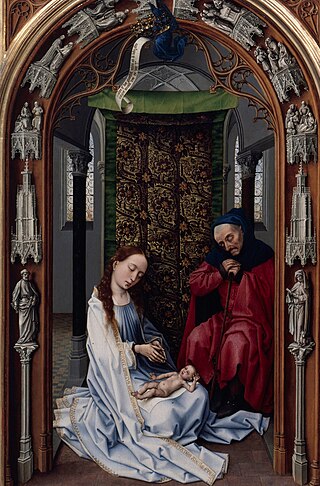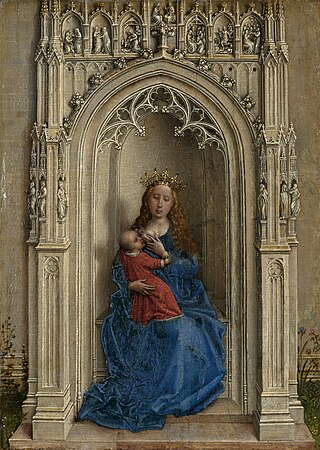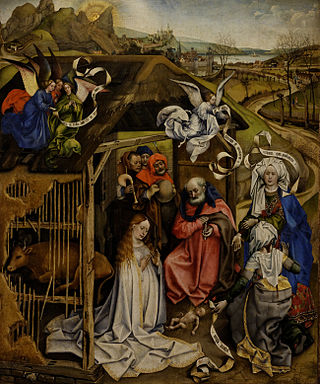
Rogier van der Weyden or Roger de la Pasture was an early Netherlandish painter whose surviving works consist mainly of religious triptychs, altarpieces, and commissioned single and diptych portraits. He was highly successful in his lifetime; his paintings were exported to Italy and Spain, and he received commissions from, amongst others, Philip the Good, Netherlandish nobility, and foreign princes. By the latter half of the 15th century, he had eclipsed Jan van Eyck in popularity. However his fame lasted only until the 17th century, and largely due to changing taste, he was almost totally forgotten by the mid-18th century. His reputation was slowly rebuilt during the following 200 years; today he is known, with Robert Campin and van Eyck, as the third of the three great Early Flemish artists, and widely as the most influential Northern painter of the 15th century.

Robert Campin, now usually identified with the Master of Flémalle, was a master painter who, along with with Jan van Eyck, initiated the development of Early Netherlandish painting, a key development in the early Northern Renaissance.

The Mérode Altarpiece is an oil on oak panel triptych, now in The Cloisters, in New York City. It is unsigned and undated, but attributed to Early Netherlandish painter Robert Campin and an assistant. The three panels represent, from left to right, the donors kneeling in prayer in a garden, the moment of the Annunciation to Mary, which is set in a contemporary, domestic setting, and Saint Joseph, a carpenter with the tools of his trade. The many elements of religious symbolism include the lily and fountain, and the Holy Spirit represented by the rays of light coming through from the central panel's left hand window.

The Descent from the Cross is a panel painting by the Flemish artist Rogier van der Weyden created c. 1435, now in the Museo del Prado, Madrid. The crucified Christ is lowered from the cross, his lifeless body held by Joseph of Arimathea and Nicodemus.

Portrait of a Lady is a small oil-on-oak panel painting executed around 1460 by the Netherlandish painter Rogier van der Weyden. The composition is built from the geometric shapes that form the lines of the woman's veil, neckline, face, and arms, and by the fall of the light that illuminates her face and headdress. The vivid contrasts of darkness and light enhance the almost unnatural beauty and Gothic elegance of the model.

The Magdalen Reading is one of three surviving fragments of a large mid-15th-century oil-on-panel altarpiece by the Early Netherlandish painter Rogier van der Weyden. The panel, originally oak, was completed some time between 1435 and 1438 and has been in the National Gallery, London since 1860. It shows a woman with the pale skin, high cheek bones and oval eyelids typical of the idealised portraits of noble women of the period. She is identifiable as the Magdalen from the jar of ointment placed in the foreground, which is her traditional attribute in Christian art. She is presented as completely absorbed in her reading, a model of the contemplative life, repentant and absolved of past sins. In Catholic tradition the Magdalen was conflated with both Mary of Bethany who anointed the feet of Jesus with oil and the unnamed "sinner" of Luke 7:36–50. Iconography of the Magdalen commonly shows her with a book, in a moment of reflection, in tears, or with eyes averted.

The Braque Triptych is a c. 1452 oil-on-oak altarpiece by the Early Netherlandish painter Rogier van der Weyden. When open, its three half-length panels reveal, from left to right, John the Baptist, The Virgin Mary with Jesus and Saint John the Evangelist, and on the right, Mary Magdalene. When the wings are closed, the work shows a vanitas motif of a skull and cross.

Saint Luke Drawing the Virgin is a large oil and tempera on oak panel painting, usually dated between 1435 and 1440, attributed to the Early Netherlandish painter Rogier van der Weyden. Housed in the Museum of Fine Arts, Boston, it shows Luke the Evangelist, patron saint of artists, sketching the Virgin Mary as she nurses the Child Jesus. The figures are positioned in a bourgeois interior which leads out towards a courtyard, river, town and landscape. The enclosed garden, illusionistic carvings of Adam and Eve on the arms of Mary's throne, and attributes of St Luke are amongst the painting's many iconographic symbols.

The Entombment is a glue-size painting on linen attributed to the Early Netherlandish painter Dieric Bouts. It shows a scene from the biblical entombment of Christ, and was probably completed between 1440 and 1455 as a wing panel for a large hinged polyptych altarpiece. The now-lost altarpiece is thought to have contained a central crucifixion scene flanked by four wing panel works half its height – two on either side – depicting scenes from the life of Christ. The smaller panels would have been paired in a format similar to Bouts's 1464–1468 Altarpiece of the Holy Sacrament. The larger work was probably commissioned for export to Italy, possibly to a Venetian patron whose identity is lost. The Entombment was first recorded in a mid-19th century Milan inventory and has been in the National Gallery, London, since its purchase on the gallery's behalf by Charles Lock Eastlake in 1861.

The Werl Triptych is a triptych altarpiece completed in Cologne in 1438, of which the center panel has been lost. The two remaining wings are now in the Prado in Madrid. It was long attributed to the Master of Flémalle, now generally believed to have been Robert Campin, although this identity is not universally accepted. Some art historians believe it may have been painted as a pastiche by either the workshop or a follower of Campin or the Master of Flémalle.

The Lamentation of Christ is an oil-on-panel painting of the common subject of the Lamentation of Christ by the Netherlandish artist Rogier van der Weyden, dating from around 1460–1463 and now in the Uffizi Gallery, Florence, Italy.

The Miraflores Altarpiece is a c. 1442-5 oil-on-oak wood panel altarpiece by the Early Netherlandish painter Rogier van der Weyden, in the Gemäldegalerie, Berlin since 1850. The three panels are each 71 x 43 cm and show, from left to right, a portrait of the Holy Family, a Pietà and Christ's appearance to Mary—a chronological reading of the birth, death and resurrection of Jesus, with Mary the focus of both wings. The altarpiece examines Mary's relationship with Christ at different stages of his life. It is notable for its use of colour, distinguished by its use of whites, reds and blues, and use of line—notably the line of Christ's body in the central panel—and, typically of van der Weyden, its emotional impact.

Durán Madonna is an oil on oak panel painting completed sometime between 1435 and 1438 by the Netherlandish painter Rogier van der Weyden. The painting derives from Jan van Eyck's Ince Hall Madonna and was much imitated subsequently. Now in the Prado, Madrid, it depicts a seated and serene Virgin Mary dressed in a long, flowing red robe lined with gold-coloured thread. She cradles the child Jesus who sits on her lap, playfully leafing backwards through a holy book or manuscript on which both figures' gazes rest. But unlike van Eyck's earlier treatment, van der Weyden not only positions his Virgin and Child in a Gothic apse or niche as he had his two earlier madonnas, but also places them on a projecting plinth, thus further emphasising their sculptural impression.

The Madonna Standing is a small painting by the Flemish artist Rogier van der Weyden dating from about 1430–1432. It is the left panel of a diptych held in the Kunsthistorisches Museum (KHM), Vienna since 1772. The right panel portrays St. Catherine and is also attributed by the KHM to van der Weyden, but is inferior in quality and generally regarded as by a workshop member.

The Virgin and Child Enthroned is a small oil-on-oak panel painting dated c. 1433, usually attributed to the Early Netherlandish artist Rogier van der Weyden. It is closely related to his Madonna Standing, completed during the same period. The panel is filled with Christian iconography, including representations of prophets, the Annunciation, Christ's infancy and resurrection, and Mary's Coronation. It is generally accepted as the earliest extant work by van der Weyden, one of three works attributed to him of the Virgin and Child enclosed in a niche on an exterior wall of a Gothic church. The panel is housed in the Museo Thyssen-Bornemisza in Madrid.

The Nativity is a devotional mid-1450s oil-on-wood panel painting by the Early Netherlandish painter Petrus Christus. It shows a nativity scene with grisaille archways and trompe-l'œil sculptured reliefs. Christus was influenced by the first generation of Netherlandish artists, especially Jan van Eyck and Rogier van der Weyden, and the panel is characteristic of the simplicity and naturalism of art of that period. Placing archways as a framing device is a typical van der Weyden device, and here likely borrowed from that artist's Altar of Saint John and Miraflores Altarpiece. Yet Christus adapts these painterly motifs to a uniquely mid-15th century sensibility, and the unusually large panel – perhaps painted as a central altarpiece panel for a triptych – is nuanced and visually complex. It shows his usual harmonious composition and employment of one-point-perspective, especially evident in the geometric forms of the shed's roof, and his bold use of color. It is one of Christus's most important works. Max Friedländer definitely attributed the panel to Christus in 1930, concluding that "in scope and importance, [it] is superior to all other known creations of this master."

Nativity is a panel painting of c. 1420 by the Early Netherlandish painter Robert Campin, now in the Musée des Beaux-Arts de Dijon, France. As often, the moment shown is the Adoration of the Shepherds. Harshly realistic, the Child Jesus and his parents are shown in poverty, the figures crowded in a small structure, with broken-down walls, and a thatched roof with a hole, the single space shared with animals. In this Campin abandons the traditional narrative.

The Saint Columba Altarpiece is a large c. 1450–1455 oil-on-oak wood panel altarpiece by Early Netherlandish painter Rogier van der Weyden painted during his late period. It was commissioned for the church of St. Columba in Cologne, and is now in the Alte Pinakothek, Munich.

A Man and A Woman is the title sometimes used for a pair of oil and egg tempera on oak panel paintings attributed to the Early Netherlandish painter Robert Campin, completed c. 1435. Although usually considered pendants or companion pieces, they may also have been wings of a since dismantled diptych. The latter theory is supported by the fact that the reverse of both panels are marbled, indicating that they were not intended to be hung against a wall.






















